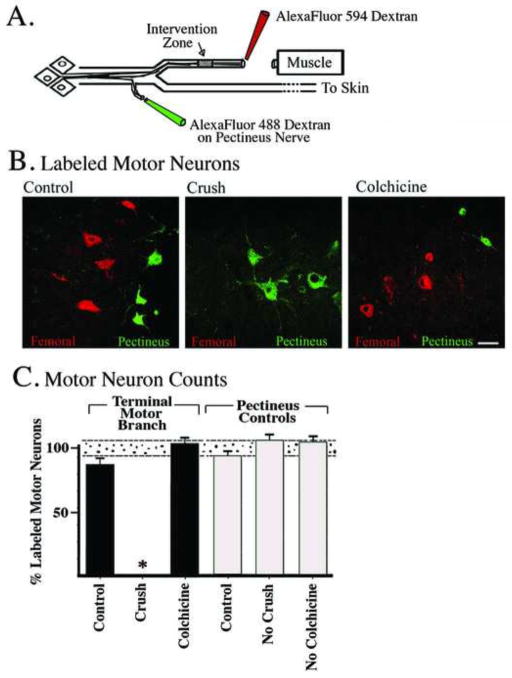Figure 4.
Disruption of diffusion driven movement and/or active axonal transport in the femoral nerve. A) Depiction of model system. B) Representative spinal cord sections from animals whose terminal muscle branch of the femoral nerve received either application of saline (control), a nerve crush, or the application of colchicine. After an additional 15 minutes the terminal muscle branch was transected just distal to the intervention zone (see A) and Alexa-594-labeled dextran was applied to the terminal muscle branch. The rational was that if the more proximal nerve intervention (saline, crush, colchicine) blocked the diffusion driven movement of the labeled dextran that was applied distally than no motor neurons would be labeled in the spinal cord. Conversely if the more proximal nerve intervention did not block the diffusion driven movement of the labeled dextran than labeling of femoral nerve motor neurons should take place. During this same labeling procedure the pectineus nerve received application of Alexa-488-labeled dextran as a control. Because of the overlap of the distribution of pectineus and femoral motor neuron pools in the spinal cord this allowed us to carefully screen those spinal cord levels for labeled femoral nerve motor neurons. C) Motor neuron counts showed that the application of saline (Control) or colchicine resulted in complete retrograde labeling of the femoral nerve motor pool and verified that the dextrans are effective even when active axonal transport is blocked by colchicine, whereas animals that received a nerve crush demonstrated no retrograde labeling of femoral nerve motor neurons. The pectineus motor neuron counts were similar for all three groups and indicated the integrity of the general labeling procedures. N=2 animals in each group; these experiments were replicated a minimum of three times using different animals (i.e. biological replicates).

